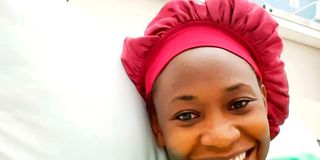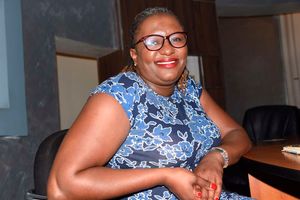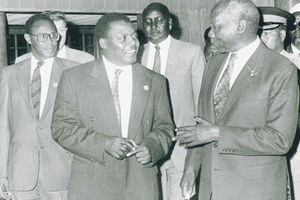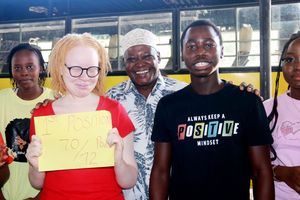Shillah Simiyu: I saw death, I was ready to get my husband a new wife

What you need to know:
- I am a medical research scientist. I have a masters in tropical and infectious diseases. I have countless doctor friends. I'm an avid reader. I had never heard of fibromyalgia.
- My first questions were to know whether it is progressive, degenerative, when I was going to die and if it were curable?
In April 2018, Shillah Simiyu, a Kenyan epidemiologist who until last month worked at the Kenya Medical Research Institute (Kemri-Wellcome Trust), travelled to Melbourne, Australia for a science conference.
Barely an hour into the flight, her ears got blocked but she dismissed it as the usual ‘airplane ear’ . She went ahead to try the Valsalva maneuver, the action of attempting to exhale with the nostrils and mouth, or the glottis closed.
Several attempts failed.
In an exclusive interview with Healthy Nation, the scientist sheds light on fibromyalgia, a rheumatic condition characterised by muscular or musculoskeletal pain with stiffness and localised tenderness at specific points on the body.
“I saw an Ear, Nose and Throat (ENT) specialist upon my arrival back home at the Aga Khan University Hospital and after a series of tests, it was established that my right eardrum was perforated.
I was given painkillers, antibiotic ear drops and the issue resolved within two to three weeks. At the time, I also had a sickly child. My youngest, who was one and a half years old at the time, used to have recurrent sleep apnea. This is a serious sleep disorder in which breathing repeatedly stops and starts.
I was also heading a research study that required retrieval of thousands of previously archived biological samples from the -80°C freezers in the biobank. Despite living at the Coast region, infamous for its warm and humid climate, I would actually arm myself with trousers, long sleeved shirts and even a sweater, just for that exercise. I was trying hard to beat some important deadlines. I would do up to 60 culture plates of the bacterial samples per day.
My samples would occupy an entire lab bench. I would be the first one in the lab and the last to leave and it didn’t take long before the cold temperatures took a toll on my health.
I found myself trying antibiotics, cough syrups, antihistamines, home remedies among others but unfortunately the cough persisted for close to three months to a point where some of my colleagues even suggested that I get checked for tuberculosis (TB), but nothing.
One Friday evening while driving home from the gym, I noticed a rash on my cheeks. I have this very strict skin care routine and I like my skin flawless. My periods were not anywhere round the corner, so the rash couldn’t have been due to hormonal fluctuations. Plus, it was quite abrupt.

While attending church service that weekend, when the service ended and the pastor asked us to stand for the closing prayer, I suddenly couldn’t. My legs were stiff, burning as if they were on fire and aching with a pain that was out of this world. When such pain hits you, you can’t even cry or scream.
The moment the pain reduced, I quickly rose, went to get my children and called a friend, who also happened to be a colleague, to watch over them so I could go to hospital. My voice was shaky, I was scared. Like what was going on? The doctor’s initial diagnosis was plantar fasciitis, an inflammation of a thick band of tissue that connects the heel bone to the toes. It almost made sense because I am a gym rat and an exercise junky.
I exercise to manage my stress. I might have overworked my legs. But when I explained that in the preceding weeks I had felt this same pain in other parts of my body, she suspected potential infection with a hemorrhagic virus, any of a group of infectious diseases that interfere with the blood’s ability to clot — the likes of dengue and chikungunya, which are endemic to the Coast region and also present with muscle pain.
We then did a full blood hemogram, which showed that I had severe thrombocytopenia, a condition where you have a low blood platelet count.
This means that I had two platelets per microliter of blood whereas a healthy person should have between 150,000 and 400,000 platelets per microliter of blood. The following day I woke up again in pain. I couldn’t fold my knees. I had heart palpitations; my entire body felt like it was on fire. My right eye and upper right lip were twitching. My husband drove me to a Mombasa hospital. We tested for dengue and did another hemogram.
My tests were clean. The general physician referred us to an endocrinologist. We did a thyroid function test, HbA1c test, Random blood sugar, Anti-streptolysin, vitamin B12 deficiency, Anti-nucleic Acid (ANA) and Anti-DNA tests for autoimmune conditions.
We had to wait a week for the results. In between, my palpitations got worse. All the tests came out clean. But I had to see a cardiologist at the Aga Khan Hospital in Mombasa. I had a 24-hour electrocardiogram (ECG) test and echo done. I was diagnosed with a mitral valve prolapse, a type of heart valve disease in which the valve between the left heart chambers doesn’t close completely. But I was told it was nothing major. Probably something I was born with. But then, why was I having palpitations suddenly?
Re-do tests
I was then referred to the Nairobi Arthritis Clinic. We did the autoimmune antibody tests again. Everything was fine. Except that this time round I had severe leukocytosis, a high level of white blood cells in the blood, but no other sign of infection.
I was to re-do the test after two weeks, and the leukocytosis persisted. Further tests suggested I had a high number of premature white blood cells. Leukemia was suspected. By this time, I was also experiencing severe migraines; my eye and lip were still twitching.
I was referred to the cancer clinic at Aga-Khan Hospital in Nairobi to test for leukaemia and for a Brain MRI to check for a brain tumour. You look fine; the doctors can’t find anything wrong with you, but you don’t feel fine. I was in pain; my eyes and lips kept twitching. My heart palpitations persisted and I couldn’t walk.
One Sunday afternoon, in our bedroom, I sat my husband down and told him I had accepted that I was dying. I told him how I would want my children raised and protected, and how I wanted to help him get a good woman as his next wife, a woman who was not going to be a horrible stepmother to my children and if not he should take the girls to their grandparents. I tried to keep a firm voice but my eyes were teary. He didn’t want to hear any of it but in my head I was busy planning my funeral.”
In mid-January 2019, my bouts of severe pain showed up again and I decided to see yet another oncologist, Dr Andrew Odhiambo, who reassured me that whatever I was dealing with was definitely not cancer.
I was then referred to a rheumatologist, one Dr Fredrick Otieno. The expert asked me to lie on his examination bed. He pressed and gently hit a few tender but painful points asking whether I felt pain in those areas. Just like that he told me that I had fibromyalgia.
I am a medical research scientist. I have a masters in tropical and infectious diseases. I have countless doctor friends. I am an avid reader. I had never heard of fibromyalgia.
My first questions were to know whether it is progressive, degenerative, when I was going to die and if it were curable? My biggest fear has always been leaving my children young, vulnerable and motherless. He told me he had patients who had lived with fibromyalgia for decades. It’s a mysterious disease. It has no cure. The causes are not known. But risk factors include surgery (I have had two CSs and a myomectomy), psychological trauma (I have a history of infertility, unresolved daddy issues, sick child, work stress) and infection (I had experienced a poorly managed, long cough a few months prior). It could have even been the eardrum perforation. I honestly can’t tell what triggered it. Fibromyalgia is basically characterised with widespread, immense and debilitating musculoskeletal pain and stiffness. The pain manifests either as aching, pins and needles or a burning sensation.
It picks its favourite part of the body. We have costochondritis and temporomandibular joint pains. It is also accompanied by migraines, palpitations, depression, anxiety, insomnia, severe lethargy, irritable bowel syndrome and interstitial cystitis.
The pain... well, I have no words to describe it. All I can say is that in my entire pre-fibromyalgia life, the pain I had experienced is nothing like this — fibromyalgia pain strives to make a statement.
Nowadays I have learnt to be resilient though I still have good and bad days.
I run a Facebook page called ‘Closet warriors’, which is basically a community of people suffering from different types of ‘invisible ‘diseases like me and the aim is to provide someone else out there with the information they need,coping mechanisms, support and encouragement as well as compare notes on therapies and latest research findings.”
This report is produced in partnership with the African Investigative Journalism Conference, an initiative of the Journalism Department at the University of Witwatersrand in South Africa, and the Nation Media Group.





